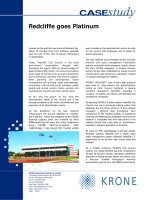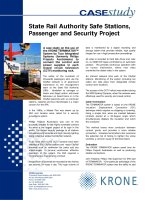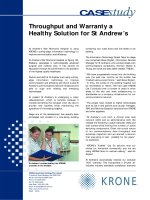Tài liệu Migrating from RIP to EIGRP pdf
Bạn đang xem bản rút gọn của tài liệu. Xem và tải ngay bản đầy đủ của tài liệu tại đây (27.15 KB, 3 trang )
1 - 3 Semester 5: Advanced Routing v2.0 - Lab 3.6.1 Copyright 2001, Cisco Systems, Inc.
3.6.1: Migrating from RIP to EIGRP
Host B
192.168.3.2 /24
Fa0/0 192.168.3.1 /24
S0/1 192.168.2.1 /24
S0/0 192.168.1.1 /24
S0/0 192.168.1.2 /24
Fa0/0 10.0.0.1 /8
S0/0 192.168.2.2 /24
Fa0/0 10.0.0.2 /8
Host A
10.0.0.11 /8
Vista
SanJose2SanJose1
Objective
In this lab, you configure RIPv2 and then EIGRP so that you can compare their metric
calculations.
Scenario
International Travel Agency (ITA) currently uses RIPv2 as its interior gateway protocol.
You have been asked to migrate its network to EIGRP.
Step 1
Build and configure the network according to the diagram. Note: Host A and Host B are
not required to complete this lab, but they might be used in testing or as Telnet clients. If
used, Host A's gateway may be either SanJose1 router or the SanJose2 router.
On all three routers, configure RIPv2 and enable updates on all active interfaces with the
network command. Here are some sample commands for SanJose1:
SanJose1(config)#router rip
SanJose1(config-router)#version 2
SanJose1(config-router)#network 192.168.1.0
SanJose1(config-router)#network 10.0.0.0
Use ping and show ip route to verify full connectivity within the network.
2 - 3 Semester 5: Advanced Routing v2.0 - Lab 3.6.1 Copyright 2001, Cisco Systems, Inc.
Step 2
As you migrate to EIGRP, you decide to leave RIP running on all the routers to avoid a
loss of connectivity. On SanJose1 and SanJose2, configure EIGRP for Autonomous
System 24, as shown below. Do not configure Vista for EIGRP yet.
SanJose1(config)#router eigrp 24
SanJose1(config-router)#network 192.168.1.0
SanJose1(config-router)#network 10.0.0.0
and
SanJose2(config)#router eigrp 24
SanJose2(config-router)#network 192.168.2.0
SanJose2(config-router)#network 10.0.0.0
Step 3
From Vista’s console, issue the show ip route command. Because you have not yet
configured EIGRP on this router, you should have a route to the 10.0.0.0 /8 network via
RIP.
1. What is the administrative distance of this route?
2. What is the metric of this route?
Enable debug so that changes to the routing table will be reported to the console.
Vista#debug ip routing
If you are connected via Telnet, you must also enter the terminal monitor command
so that you can see the logging output.
Now enable EIGRP on Vista.
Vista(config)#router eigrp 24
Vista(config-router)#network 192.168.1.0
Vista(config-router)#network 192.168.2.0
Vista(config-router)#network 192.168.3.0
3. After you made this configuration, did debug report any changes to the routing table?
If so, what were they?
Issue the show ip route command again from Vista. You should now have an EIGRP
route to network 10.0.0.0 /8.
4. What is the metric of this route?
5. Because this metric is higher than the metric of the RIP route, why did Vista choose the
EIGRP route over the RIP route?
3 - 3 Semester 5: Advanced Routing v2.0 - Lab 3.6.1 Copyright 2001, Cisco Systems, Inc.
Step 4
To see more with the debug ip routing command, force the routing table to rebuild
with this command:
Vista#clear ip route *
1. According to the debug output, what is the administrative distance of Vista’s connected
routes?
2. What is the metric of the connected routes?
Step 5
To complete the migration from RIP to EIGRP, you must disable RIP on all three routers.
Be sure to turn off debug before exiting the Vista router.
Vista#undebug all









